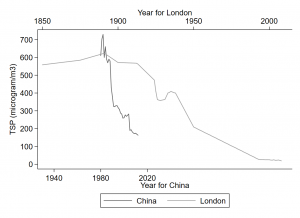Beijing has seen some of the lowest air pollution levels in recent history this past winter, just as China’s Ministry of Environmental Protection (MEP) – now strengthened and renamed to Ministry of Ecology and Environment (MEE) – has put the final touches on a new, three-year plan to improve air quality. But while the trend is positive, air pollution levels in China are still dire: The MEP calculates an annual average PM2.5 concentration of 43 µg/m3 for China’s cities in 2017, more than 4 times the level of 10 µg/m3 recommended by the WHO. Official measurements for Beijing even showed the capital’s air quality at 58 µg/m3
Still, China is cleaning up its air faster than the United Kingdom did after its Industrial Revolution. Despite this early success, however, China could spark even more efficient improvements by adopting market-based incentives.
Let’s take a look at how both countries fared immediately after each of their industrial booms.

Figure notes: The figure shows annual average concentrations of total suspended particles (TSP), a coarse and now outdated measure of air pollution. The black line shows the average for China, while the grey line shows London. Data sources: TSP concentrations for China through 2003 are based on the China Energy Databook 9.0 based on data provided by State Environmental Protection Administration. From 2004 on, TSP concentrations for China are based on author-collected air pollution index (API) data from the MEP datacenter. I imputed PM10 concentrations based on information on the main pollutant on a given day and the assumption that an API reading below 51 reflects PM10 (see Stoerk 2016 for explanations on the procedure). I then converted the PM10 concentrations into TSP using a conversion factor of 2 following Matus et al. 2012. TSP concentrations for London come from Fouquet 2011, who generously shared his dataset.
Air quality in London is far from perfect, but it’s also come a long way from the days when people died in the “Great Smog.” The graphic above brings together the earliest known air pollution data from China, from 1980 to 2012, and from the UK from the Industrial Revolution until 2008. Air pollution levels in the main Chinese cities at the beginning of the 1980s were almost exactly at the level of London at the height of the Industrial Revolution in 1890 (a shocking outlier is Hohhot, the capital of Inner Mongolia, which reached a concentration of Total Suspended Particles of 1,501 µg/m3 in 1987, possibly the highest level of urban air pollution in recorded history).
The difference is in the speed of improvements: Air pollution in China has been decreasing at a similar trajectory as London’s 90 years earlier, but at twice the pace. While extreme air pollution levels in China’s recent history are typical for an industrializing economy, its pace in cleaning up the pollution is fast by historical standards.
China started to seriously control air pollution from 2006 to 2010 by limiting emissions for each province. Relying on satellite data, my research shows that this first attempt was ultimately successful in reducing nationwide SO2 emissions by over 10 percent relative to 2005. Studying compliance over time, however, suggests that reductions in air pollution only happened after the Chinese government created the MEP in 2008. After its creation, among the many changes in environmental policy, the MEP started to gather reliable SO2 emissions data from continuous emissions monitoring systems (CEMS) at the prefecture level and increased the number of enforcement officials by 17 percent (a task that EDF China actively supported).
This early success notwithstanding, China could do better by implementing well-designed market-based solutions, policies that align with the country’s ambition to combine economic prosperity and environmental protection. Or, in the words of President Xi, to combine ‘green mountains and gold mountains’.
For example, a well-designed cap-and-trade program at the province level could have decreased the cost of air pollution abatement from 2006 to 2010 by 25% according to my research. The anticipated launch of a sectoral emissions trading system to limit a portion of China’s greenhouse gas emissions suggests that the Chinese government is looking to embrace lessons learned in air pollution control and wishes to build on its own pilot market-based pollution control programs to bring its environmental policy into the 21st century.
EDF is playing a key role in helping this endeavor through both hands-on policy work and research. The timing is serendipitous: China is at a cross-roads in environmental policy. Evidence based policy making is welcome. And data quality has improved in recent years. Given the right set of policies, countries can control air pollution, and improvements in air quality typically go hand in hand with economic prosperity.
Both China and London have remaining challenges. Despite dramatic improvements, Londoners, like the Chinese, still live with significant air pollution. A recent report on London’s air pollution found the city is not close to meeting WHO standards. Meeting them will be a challenge, in part because of the complexity of the causes (road transport accounts for over half of local contributions). So just as London must keep battling to improve air quality, Beijing will need to do likewise–but at least now each can now learn from the other.









